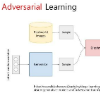Semantic communication is a novel communication paradigm that focuses on recognizing and delivering the desired meaning of messages to the destination users. Most existing works in this area focus on delivering explicit semantics, labels or signal features that can be directly identified from the source signals. In this paper, we consider the implicit semantic communication problem in which hidden relations and closely related semantic terms that cannot be recognized from the source signals need to also be delivered to the destination user. We develop a novel adversarial learning-based implicit semantic-aware communication (iSAC) architecture in which the source user, instead of maximizing the total amount of information transmitted to the channel, aims to help the recipient learn an inference rule that can automatically generate implicit semantics based on limited clue information. We prove that by applying iSAC, the destination user can always learn an inference rule that matches the true inference rule of the source messages. Experimental results show that the proposed iSAC can offer up to a 19.69 dB improvement over existing non-inferential communication solutions, in terms of symbol error rate at the destination user.
翻译:语义通信是一种新颖的通信模式,其重点是向目的地用户承认和传递信息的理想含义。这一领域的现有工作大多侧重于提供可以从源代码信号直接识别的明确语义、标签或信号特征。在本文件中,我们考虑了隐含语义通信问题,其中隐含语义关系和从源代码信号中无法识别的密切相关的语义术语也需传递给目的地用户。我们开发了一种新型的对抗性学习基于隐含语义认知通信(iSAC)结构,在这种结构中,源用户而不是最大限度地增加传送到该频道的信息总量,目的是帮助收件人学习一条可以根据有限的线索信息自动生成隐含语义的推论规则。我们证明,通过应用iSAC,目的地用户可以始终学会一条与源信息真实的推论规则相匹配的推论。实验结果表明,拟议的iSAC可以对现有非推定通信解决方案提供19.69 dB的改进,即指目的地用户的符号错误率。



